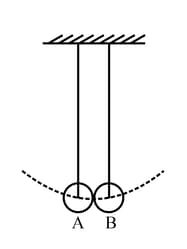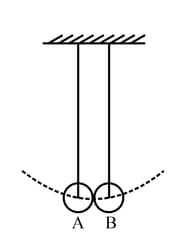NCERT Solutions for Chapter: Work, Energy and Power, Exercise 4: SA
NCERT Physics Solutions for Exercise - NCERT Solutions for Chapter: Work, Energy and Power, Exercise 4: SA
Attempt the practice questions on Chapter 6: Work, Energy and Power, Exercise 4: SA with hints and solutions to strengthen your understanding. NCERT Exemplar Physics - Class 11 solutions are prepared by Experienced Embibe Experts.
Questions from NCERT Solutions for Chapter: Work, Energy and Power, Exercise 4: SA with Hints & Solutions
A raindrop of mass falling from a height of hits the ground with a speed of . Calculate
(b) the gain in K.E. of the drop.
A raindrop of mass falling from a height of hits the ground with a speed of . Calculate
(c) Is the gain in K.E. equal to loss of P.E.? If not why? (Take )
Two pendulums with identical bobs and lengths are suspended from a common support such that in rest position the two bobs are in contact (figure). One of the bobs is released after being displaced by so that it collides elastically head-on with the other bob.

(a) Describe the motion of two bobs.
Two pendulums with identical bobs and lengths are suspended from a common support such that in rest position the two bobs are in contact as shown in figure. One of the bobs is released after being displaced by so that it collides elastically head-on with the other bob.
Draw a graph showing variation in energy of either pendulum with time, for , where is the period of each pendulum.

Suppose the average mass of raindrops is and their average terminal velocity . Calculate the energy transferred by rain to each square metre of the surface at a place which receives of rain in a year.
An engine is attached to a wagon through a shock absorber of length . The system with a total mass of is moving with a speed of when the brakes are applied to bring it to rest. In the process of the system being brought to rest, the spring of the shock absorber gets compressed by . If of energy of the wagon is lost due to friction, calculate the spring constant.
An adult weighing raises the centre of gravity of his body by while taking each step of length in jogging. If he jogs for , calculate the energy utilized by him in jogging assuming that there is no energy loss due to friction of ground and air. Assuming that the body of the adult is capable of converting of energy intake in the form of food, calculate the energy equivalents of food that would be required to compensate energy utilised for jogging.
On complete combustion a litre of petrol gives off heat equivalent to J. In a test drive a car weighing including the mass of driver, runs per litre while moving with a uniform speed on a straight track. Assuming that friction offered by the road surface and air to be uniform, calculate the force of friction acting on the car during the test drive, if the efficiency of the car engine were
